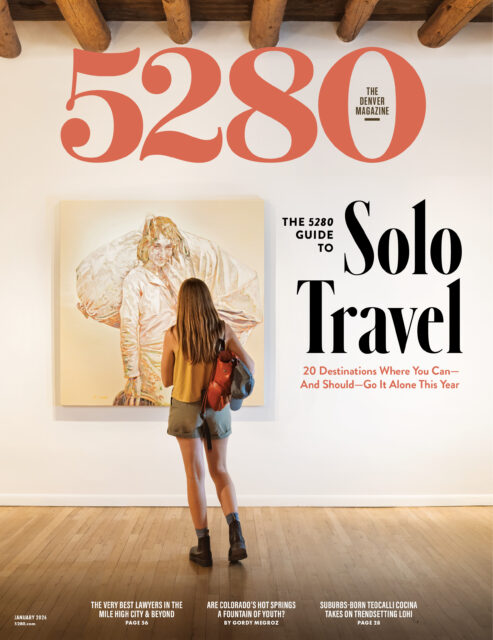The Local newsletter is your free, daily guide to life in Colorado. For locals, by locals.
Editor’s note: On February 5, Tegan Bartholomew Brown officially became one of the first females to earn the Eagle Scout distinction.
Growing up in Boulder, Tegan Bartholomew Brown, 18, has always led an active life. She’s a certified ski patroller, who has worked the Front Range backcountry and Devil’s Thumb Ranch with Bryan Mountain Nordic Ski Patrol. She also has a goal of climbing all of Colorado’s 58 fourteeners and has recently taken up ultrarunning. “The mountains have always been a huge part of my life,” she says.

So it should be no surprise that when she was younger, the hiking and backpacking trips that her brother Caspar, now 15, was taking with his Boy Scouts of America (BSA) group, Troop 171, piqued her interest. “[Caspar] joined [the troop] when he was in sixth grade, and I thought the trips he went on were really neat,” Brown says. “They were much longer and more rigorous than anything I’d been able to do with the Girl Scouts: canyoneering, 50-plus mile backpacking trips, etc.”
Now, Brown is set to become one of the first females in the United States to reach the Eagle Scout rank, scouting’s highest achievement. A few other females are also on the verge of the same accomplishment, which only about four percent of scouts manage to complete. “To reach it, Tegan must earn 21 merit badges, 13 of which are required and the rest are electives,” says Marta Turnbull, scoutmaster for Troop 171G. “She must also demonstrate Scout spirit—based on the Scout Oath and Scout Law—provide leadership, complete a rigorous and significant service project, and pass a board of review.”
Brown is the oldest scout in Troop 171G, the first and only girls-specific troop in Boulder’s Scouts BSA program. Today, kids between the ages of 11 and 17 are welcome at BSA troops across Colorado, regardless of gender, but it wasn’t always this way. Prior to February 2019, the Boy Scouts program was solely for boys, while Girl Scouts of the USA (GSUSA) was offered for girls. The Boy Scouts’ decision to rebrand as the gender-neutral Scouts BSA in 2019 has sparked legal battles between the two groups, but the programs themselves have different priorities. BSA tends to focus more on outdoor adventure and survival skills and has a hierarchical structure—meaning scouts have to earn merit badges to move up in rank—while GSUSA focuses on developing girls’ leadership skills, offers flexibility in earning badges that align with a scout’s interest, and groups participants by age instead of rank.
Brown’s Troop 171G now has nine girls, all of whom have goals to reach the Eagle Scout rank. Boys and girls are still in distinct troops—171G (girls) is linked with Troop 171B (boys)—but they share resources, sponsors, adult committees, scoutmasters, equipment, requirements, and goals.
Traditionally, scouts are required to earn the Eagle Scout ranking by their 18th birthday, but they’re making an exception for Brown, who joined the troop as soon as it was open, when that milestone was just over a year away. “I wanted to set a positive example for the younger girls in the troop,” she says. “At the time I joined, the oldest ones were 11 or 12, so I wanted to show them that they could do it too, because I think it’s a really positive experience for all kids to have. I’m really excited that girls have that opportunity now.”

Brown says that of the thirteen required merit badges she needs to earn—which range from citizenship in the world and nation to emergency preparedness and sustainability to personal management—she only has the camping badge left to fill. She’s also been working on her service project at Rocky Mountain Therapeutic Riding Center (RMRT) in South Boulder, a therapeutic horseback-riding center dedicated to working with children and adults who have a variety of physical, cognitive, and emotional disabilities.
“RMRT wanted to make their sensory trail mobile. A sensory trail has a series of experiences along a route that are designed to immerse people in a multi-sensory journey,” Brown says. The project was meant to challenge the students’ balance, stimulate their senses, and encourage them to interact with the world around them. “To make the large items of the sensory trail safely mobile, we built wooden frames and added casters to support the items as they are moved.”
Brown says the toughest part of working toward Eagle Scout has been balancing the requirements for the rank with college—she’s currently a freshman at Vanderbilt University in Nashville, having graduated with honors from Fairview High School in 2020—and trying to maintain a normal, 18-year-old life. “Some of the merit badges take a certain amount of time, so I had to make sure I started those early,” she says. “I was working on requirements while I was at college this past fall. It seemed pretty overwhelming at times, and I wasn’t sure I would finish it. I’m happy I’ve had a nice long winter break to make a lot of progress on it before I start back at school.”
Turnbull says that Brown epitomizes the future of Scouting. “I think the future is about providing equal opportunity, leadership, and service to the community,” she says. “It’s about helping everyone learn outdoor and life skills, while having lots of fun.”
Brown is expected to earn Eagle rank by the beginning of February, and although she’s plenty busy with college, she hopes to continue to be involved with Scouts BSA in the future—especially if that means encouraging more girls to earn the Eagle Scout rank. “I’m not sure specifically how it will impact my life going forward, but I think it’s a huge honor to be one of the first female Eagle Scouts,” she says. “I know it’s something I’ll have for the rest of my life.”








